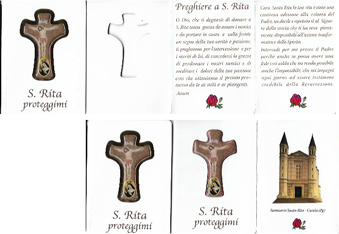 |
Saint Rita of Cascia |
St. Rita Medal - With Picture-Gold ColorWas $2.50 / Now $1.50 |
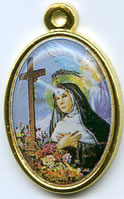 |
 |
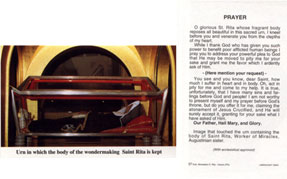 |
|
St. Rita The Driver's Prayer Holy Card - 50¢ ea.
|
St. Rita Prayer Card (2 7/8" x 4 1/2") Features Urn with St. Rita's incorrupt body - $1.00 ea. |
Prayer For Students |
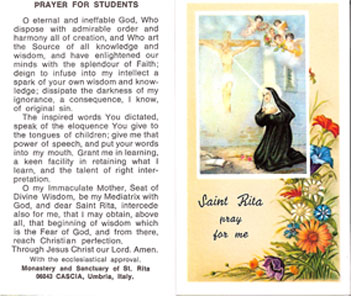 |
|
St. Rita Prayer Card - Prayer for Students (1)
(2 3/8" x 4 1/8") 25¢ ea. |
|
|
St. Rita Pictures and Prayer Folders |
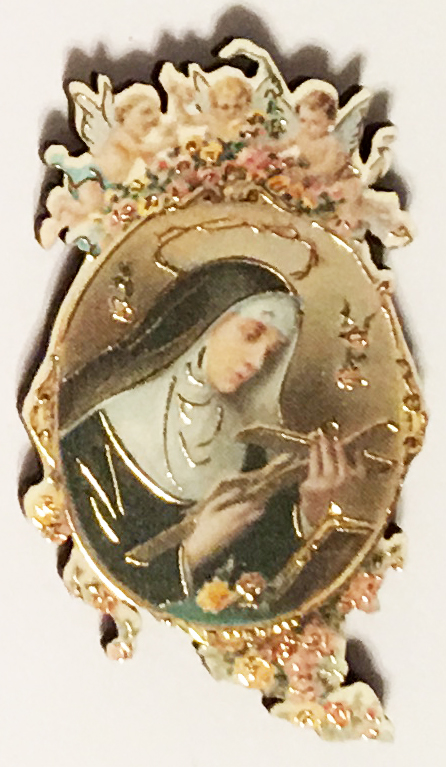 |
|
St. Rita of Cascia Shrine Folder - Italian - $1.25 |
St. Rita - Small Picture (1.75 Inch) with Adhesive Backing - $1.50 (only 2 left) |
| The following account of the life of St. Rita of Cascia is taken from A Mother's Point of View (Catholic News & Commentary - Vol. 14, Nos. 7 & 8) | ||||||||||||||||||||||
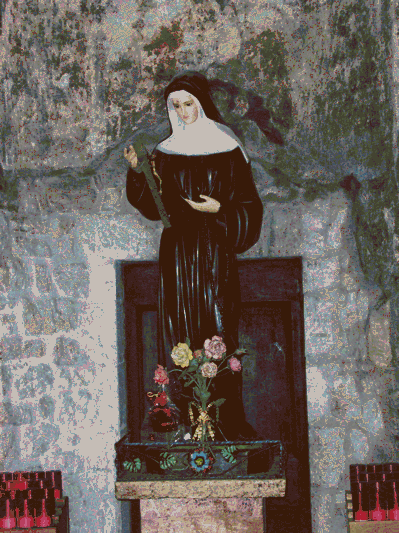 |
On Saturday, May 22, 1382 – during the reign of Pope Urban VI – in a small village, three miles from Cascia, Rita was born to Antonio Mancini and Amata Ferre. Antonio and Amata were an older pious couple who had consecrated every day of their wedded life to the service of God, spending their time caring for the poor. One night, while Amata was praying, an angel appeared to her in a vision and told her that it was the will of God that she would have a daughter who would, from her birth, be marked with a seal of sanctity. God made it known to Amata that her name would be Rita, which was given to her four days after her birth when she was baptized at St. Mary’s Church in Cascia. Five days after her birth, a swarm of bees hovered over Rita as she slept in her cradle. “The bees alighted on her lips,…, and were seen to enter and issue forth from her partially opened mouth without harming her or causing her to awaken from her slumber.… The bees were a presage of Rita’s future Beatification that was to take place when the bees of Urban VIII reigned in the Church.” (St. Rita of Cascia; Fr. Sicardo; p. 32) Over six centuries later, a small swarm of bees still dwells in a small fissure in the convent wall, midway between Rita’s cell and her sepulchre. The bees have no sting! They live retired for most of the year, but leave their tiny abode during the last few days of Holy Week and return on the feast of St. Rita. On one occasion, one of the bees was sent in a glass vase to Urban VIII. It remained only a day, escaped its glass prison, and then returned to its companions in Cascia. |
|||||||||||||||||||||
|
Statue of St. Rita at the Church in Rocca Porrena
|
||||||||||||||||||||||
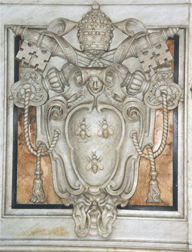 |
||||||||||||||||||||||
|
As a small child, Rita preferred being alone to contemplate the Passion of Christ. She was obedient and often knelt at the feet of her aged mother, listening to her holy counsel. The virtues of innocence and purity were deeply rooted in her pure soul. At mealtime she always ate a portion of her food, and gave the rest to the poor. At the age of 12, she consecrated her virginity to God to become a true spouse of Christ. When she made this known to her elderly parents, their hearts were broken as they wished their family to be saved from extinction. Rita’s heart nearly broke when her parents chose a husband for her. She reminded them that instead of entering the convent she had remained to take care of them until God took them to a happier home. Rita spent many hours in prayer waiting for God’s answer to this problem as she didn’t want to be disobedient to her parents, but she wanted to do God’s will. When she realized it was God’s will to be obedient to her parents, she prostrated herself at their feet, humbly asking pardon and was willing to embrace whatever state of life they wished her to enter. Ferdinando, the son of well-to-do and influential parents, was chosen to be Rita’s husband. |
||||||||||||||||||||||
| The Coat of Arms of Pope Urban VIII - Note the Three Bees which are a symbol of his papacy. | ||||||||||||||||||||||
|
He was always harsh and cruel to Rita. After a short while, she realized her marriage was an apprenticeship to trials and sorrows. He would have bursts of anger and squandered much of their money. As a wife, Rita was very patient and ran a neat, orderly home. After Ferdinando’s rage would subside, she would remind him of how his anger offended God. She was the model of a perfect wife! In a vision, Ferdinando saw what manner of a man he had become, and became truly penitent and thanked God for giving him such a humble and patient wife. Peace and harmony were established in their home from then on. Shortly after Ferdinando’s conversion, Rita’s parents died, never having seen the two boys, Giovanni and Paulo, who were subsequently born to Rita and Ferdinando. The boys were taught to be obedient, truthful, respectful and indifferent to the things of the world. They were taught to love God and dread sin. Not long after peace and love had been firmly established in this marriage, Ferdinando was attacked and stabbed to death by his enemies. Rita and her sons had been waiting to have dinner with him when they received word of his death. Rits’s heart was broken and she wept inconsolably! “What grieved her heart and soul the most, was that he passed from this life to the other without being fortified with the Viaticum which gives the dying Christian the happy assurance of a safe journey from time to eternity” (Ibid. pp. 50-51). Rita asked God’s pardon and forgiveness for his faults and failings. Rita turned her time and attention to her two growing sons and prayed to preserve their innocence and to guide them on the path of God’s holy law in which she instructed them. As they advanced in age, Rita began noticing a change in her sons. Like their father prior to his conversion, they were becoming sullen and irritable, and now wanted revenge on their father’s murderers. Rita prayed and tried to reason with them. She fled to the crucifix fervently beseeching Christ either to change their desires or no longer spare their lives. Both her sons died within a year, well prepared to go before the judgment seat of God. After the death of her sons, Rita again resolved to live solely for God. She offered rigorous penances, dressed in a garment of hair cloth, increased her number of fasts, and never left home except to go to the church or to help the needy. She pleaded with the prioress at the Augustinian convent to admit her. However, the rule was to admit only young girls whose vocations were certain or widows by special dispensation. Since no widows had been admitted from the time of its foundation, her request was denied. Three requests were made, and all were denied. Rita called upon her patrons, St. John the Baptist, St. Augustine, and St. Nicholas of Tolentine! One night, while in prayer, Rita was distracted by a knock on the door. She found no one there so resumed her prayers. She again heard the knock, and a voice which said, “Rita! Rita! Fear not, God will admit you into the cloister as His spouse.” She saw in a vision the three saints she had called upon to intercede for her. “Come, Rita, my beloved. It is now time for you to enter the Maddelina convent whose door was so often closed against you.” (Ibid. p. 65). Rita arose and followed St. John the Baptist. Together they climbed through the rugged terrain. Along the way there appeared to her Saints Augustine and Nicholas, radiant in light. She knelt down before them and thanked them for all the favors given her. They commanded her to rise and follow them. They led her to the Maddelina convent and although the doors were closed tightly, she was led into the cloister and was told: “Rita, remain a rational bee in the garden of the Spouse whom you have so long and ardently loved; so that, collecting the flowers of virtues, you may build a sweet honeycomb! You are now in the house of your Spouse, Jesus. Love Him with all your heart and soul, and your eternal salvation is secure. Return thanks to God for so great a favor done in your behalf. Praise His infinite mercy, and publish that there is nothing impossible to God. Rita, the impossible is overcome on your behalf.” The three saints then disappeared and Rita spent the remainder of the night in thanksgiving. When morning came, the nuns were surprised and astonished to see Rita in the convent. Rita told them the story of how she came to be there. All the nuns welcomed her into their community and asked pardon for refusing her so many times. Before receiving her religious habit, Rita returned to Rocca Porrena, her home, to sell her property. She distributed the proceeds among the poor and the needy. Then her long awaited dream to become the bride of Christ occurred when she received the Augustinian habit. She lived as a model novice, surrendering body, soul, and will to her beloved. After completing her novitiate, Rita made her solemn profession of the three vows of poverty, chastity and obedience. As Rita knelt before the crucifix in her little cell, she had a vision of a ladder standing upon the earth leading to heaven. God was at the top, beckoning her to ascend. She heard a voice, “Rita, if you wish to unite yourself to God in Heaven, you must climb this ladder.” (St. Rita of Cascia, Fr. Joseph Sicardo, O.S.A., p. 76) She came to understand that she had to become like the angels if she were to follow in their footsteps, and that she “must build at once a spiritual ladder, on whose steps made of virtues, she could ascend to Heaven and enjoy there for all eternity the presence and companionship of God.” (Ibid.) The first step of the ladder to be mastered was the virtue of obedience. In putting her obedience to the test, the mother superior gave Rita an unusual command. “Sister Rita, do you see that stick lying on the ground?” “Yes, Reverend Mother.” “Take it and plant it and water it every day.” Yes, Reverend Mother,” Rita replied obediently. (Life of St. Rita of Cascia, Fr. Anatasio Anglini, Aug.) |
||||||||||||||||||||||
| Some have suggested that the nuns may have looked upon it as a joke, but they admired Rita for her fine sense of obedience. And plant the stick she did – and watered it every day for a year. Then the “stick” put forth leaves and became the most beautiful and bountiful grape vine in the convent garden. Today, almost 600 years later, that same grape vine remains bountiful and beautiful. Every year some of these grapes are sent to the pope, some to cardinals and various people in high positions in the state. The leaves are dried and powdered and sent all over the world as relics to people who are suffering. There have been many cures reported due to use of the grape leaves. The second step to be mastered was the virtue of poverty. To imitate the poverty of her spouse, Jesus Christ, upon Whom she meditated daily, Rita chose to wear the same habit from the day of her entrance into the convent, and was even buried, in that old, patched habit. |
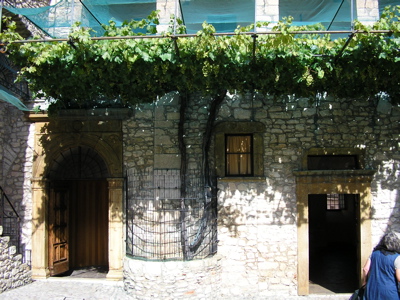 |
|||||||||||||||||||||
| The Grape Vine -- as it is today -- which grew from the "stick" that St. Rita placed in the ground and nurtured for one year. The Vine is still very vigorous and produces an abundance of grapes. The door to the chapel in which she was found by the sisters after being miraculously transported there, is on the right. | ||||||||||||||||||||||
|
Whenever Rita was obliged to go outside the convent, she always wore a thick veil over her face and never spoke to anyone. In these ways, she mastered chastity, which was the virtue represented by the 3rd step of the ladder. In order to master another virtue, that of silence, Rita often carried a small stone in her mouth to prevent the movement of her tongue. Rita slept only a few hours at night, the rest of the night was spent in prayer or doing needlework. Next to her body she wore a rough garment interwoven with thorns which penetrated her delicate flesh. She often scourged herself with small chains and leather thongs. First for the souls in Purgatory, second, for the benefactors of the convent, and third, for the souls in a state of mortal sin. Healings |
||||||||||||||||||||||
| A Mark Of The Passion On one occasion, a Franciscan friar named Blessed James of Mount Brandone, came to the church of St. Mary to preach on the Passion and Death of Jesus Christ, focusing mostly on the Crown of Thorns. Rita wept as though her heart was broken. After the sermon was over, she went to her cell and prostrated herself before the Crucifix, meditating on the pains Christ suffered from the thorns. She asked Jesus to give her at least one of the 72 thorns which pierced His poor head, causing Him so much pain and suffering, that she might feel a part of that pain. Upon completion of that prayer, Rita’s Divine Spouse granted her wish, “Making of His Crown of Thorns, so to speak, a bow, and one of the thorns, an arrow. Jesus fired it at the forehead of St. Rita with such force, that it penetrated the flesh and bone, and remained fixed in the middle of her forehead, leaving a wound that lasted all her life, and even to this day, the scar of the wound remains plainly visible.” (St. Rita of Cascia; p. 111) |
||||||||||||||||||||||
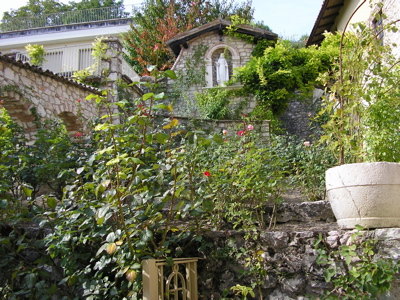 |
||||||||||||||||||||||
| Roses from the original miraculous rose continue to flourish outside St. Rita's cell at the Monastery at Cascia. | ||||||||||||||||||||||
| The pain was so intense that Rita fell into a swoon. She would have died right there had Jesus not preserved her life. The pain caused by the wound increased daily. It became so ugly, foul smelling and revolting, that Rita became an object of nausea to many who saw it. As a result, Rita asked permission to spend most of her time alone in her cell, but she was happy. Little worms fed themselves on the open wound, thus giving her new occasion to practice patience. The year 1450 was proclaimed by Pope Nicholas V as a Jubilee Year, thus providing many indulgences for those who would go on pilgrimage to Rome. Several of the sisters were given permission to go. At the feet of her superior, St. Rita also asked permission to go. Fearful that those who might observe the ugly and foul smelling wound might be scandalized, the superioress denied her permission to go unless the wound would disappear. Rushing to the feet of her Divine Spouse, Rita humbly sought God’s will, asking Him to take away the wound, but to continue to allow her to suffer the pain from the wound. The wound disappeared at once. Rita gave thanks and rushed to her superioress, who was surprised and astonished – and Rita was granted permission to accompany the other nuns to Rome. The sisters visited the stational churches and the tombs of the martyrs. Many were touched by Rita’s devotion and piety. As they returned to the convent – just as Rita stepped over the threshold, the ugly wound reappeared on her forehead, and she suffered intense pains. The offensive odor and the worms reappeared also. When one of the worms fell to the floor, Rita picked it up with care, and placed it back in the wound. She called them “her little angels,” as they were instruments for testing her patience as they recalled to her the intense suffering of her Jesus. She once again retired to her cell so as not to inconvenience the other nuns. For four years after her return from Rome, the pain intensified and her life became a real martyrdom. The Son of God visited and consoled her many times, thus satisfying her thirst. After Our Lord disappeared, there remained in Rita’s heart, so deep a wound that she became ill with divine love, suffering such attacks of fever that she lay on her hard bed, more dead than alive. During those four long years of pain, Rita never complained, and throughout that time was miraculously nourished by the Body and Blood of Jesus. |
||||||||||||||||||||||
|
One day in the month of January, one of Rita’s cousins came to visit, asking if she could do any favor for her. Rita was very ill that day but was inspired to ask her cousin to bring a rose from her garden at her former home in Rocca Porrena, which had been sold, the proceeds being given to the poor. The request surprised her cousin, who was convinced no rose would be found since the climate was very cold in January, and one could see nothing but snow and ice. However, upon entering the garden, Rita’s cousin found a beautiful red rose blooming in the snow. She plucked the rose and quickly took it to Rita. She kissed it and gave thanks to God, as did all the nuns. To commemorate this miraculous event, roses are blessed each year in all the churches of the Augustinian order on the Feast of St. Rita and distributed to the faithful. Cuttings from the original rose bush are still growing in the garden outside St. Rita’s cell. Rita also asked her cousin to bring her 2 figs from the frozen fig tree in the garden at Rocca Porrena, which she did. Once again, Rita and the nuns gave thanks. These two miracles were a sign that Rita’s life on this earth was nearing its completion. Rita knew these were divine predictions of her coming death. “She already seemed to hear the very same words that the Divine Bridegroom of the Canticles spoke lovingly to His spouse: ‘Arise, make haste, my love, my dove, my beautiful one, and come. For winter is now past, the flowers have appeared and the fig tree has put forth her green figs. Show me thy face, and let thy voice sound in my ears; for thy voice is sweet, and thy face comely.’” Jesus accompanied by His blessed Mother, appeared to Rita a short time before her death. Jesus spoke these words: “I am your Celestial Spouse, who kindled in your heart the fire of divine love, and filled your soul with virtues, in accordance with your ardent desires. I now come to tell you glad and joyful news. Rita, within a few days, you will depart from this world, to enjoy an eternal rest in your celestial country.” (Ibid. p. 126) Rita’s heart filled with joy as she knew her suffering was about to end and that the gates of Heaven would soon be opened to her. The nuns knelt around her bed and gazed with tearful eyes on their beloved sister. Rita humbly asked pardon and forgiveness for her faults and failings, and for the inconveniences she caused them because of the ugly wound on her head and the confinement to her cell. The nuns cried that they were about to lose the one who had so often consoled them. Rita told them that she was getting ready to “close her eyes to the world and open them to God,” so she could live with her beloved Spouse. Rita then asked to receive the Last Sacraments, which she did, then asked her Divine Spouse to open the gates of heaven to her. She then called upon our Blessed Mother, the angels, and her powerful intercessors St. John the Baptist, St. Augustine, and St. Nicholas of Tolentino, to introduce her into the palace of eternal joy. Rita then asked for the blessing of her superioress. Her final and parting words were: “Love God above all things. His goodness being infinite, and His beauty without comparison, you should keep always before your minds the great love He has for you as Father, Spouse, and Master. Love one another with a reciprocal chaste and holy love. Observe faithfully the rule you have professed, and venerate with a religious affection our great and holy brother, St. Augustine, who has pointed out to you, by his rule, the royal road to glory. Be obedient to Holy Mother Church, and your superioress, as you promised when you made your solemn profession.” (Ibid. p. 129) Rita then blessed the nuns with the last words she was heard to utter on earth: “’May God bless you and may you always remain in holy peace and love with your beloved Spouse, Jesus Christ.’ Then, fixing her eyes on the crucifix, St. Rita’s soul took flight from this world to an eternal rest in the arms of her Divine Bridegroom, Jesus Christ.” (Ibid.) At the moment Rita expired, May 22, 1457, one of the nuns saw angels taking her soul to heaven. She was 76 years old – 46 years as an Augustinian nun. Immediately after Rita died, her cell was aglow with a supernatural light and her body sent forth a sweet odor which filled the whole convent. The worms from the wound in her forehead became pretty lights which twinkled like stars, and her wound shown with the brilliance of a ruby. Her frail, thin body became soft and fresh and Rita appeared peaceful and much younger. Bells rang throughout Cascia – in the convents and churches – as though rung by the angels. The nuns prepared her body for burial and she was placed in the same habit and headdress she had worn since her entrance into the convent. |
||||||||||||||||||||||
|
Miracles also occurred as people came to pay their last respects to Rita; one of which was a relative whose arm had been paralyzed for years. It was instantly cured. People broke out in joy and gladness as they praised and thanked God for this miracle. The nuns went to the home of Francis Barbari, a local carpenter, to ask if he could build a coffin for Rita. They found him so sick and feeble that he could not move a hand or a foot. He promised to make the coffin if he could be cured through Rita’s intercession. He was immediately cured and made the coffin which still holds St. Rita’s body. Rita’s body was brought to the center of the oratory where the crucifix was when Rita prayed and received the wound in her forehead. An altar has been built over her body so people can still see her face. The house in Rocca Porrena where Rita was born and lived later became a church. |
||||||||||||||||||||||
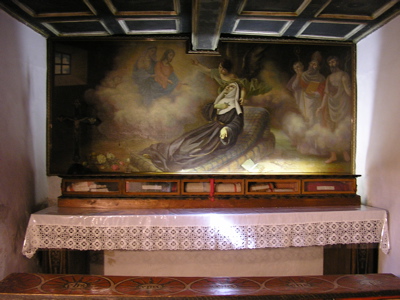 |
||||||||||||||||||||||
| The Image of St. Rita being received by Our Lord and Our Lady in Heaven. The images rests upon a cabinet which hold many of St. Rita's rellics and other items associated with her. | ||||||||||||||||||||||
|
St. Rita’s body remains as it was when she died, it has not become corrupted – she appears as in a sound sleep. From time to time, the nuns place pieces of linen or woolen clothes on her body which they then cut into small pieces to be distributed as 2nd Class relics among the faithful. Many healings and miracles have taken place as a result. The bees that first swarmed around Rita as an infant, and again when she entered the convent, are now retired in the convent wall. Every Holy Week they leave the convent until the feast of St. Rita. Often times during the year they fly through the convent or the garden, only after first flying to Rita’s cell, as if they needed permission to do so for their recreation. They are constant companions of the nuns while they are kneading the dough to make the little breads of St. Rita. These little breads are distributed on her feast day after being touched to the body of St. Rita. They are to be eaten in times of serious illness and are used during bad weather. One should recite an our Father and Hail Mary with their use. There have also been many miracles attributed to the oil from the lamp at St. Rita’s tomb. Her body has also levitated at times, especially on her feast day, May 22. In 1626, Pope Urban VIII requested a thorough investigation into the life of St. Rita in preparation for her beatification. The nuns sent one of the little white bees, which appeared at Rita’s birth, to the Holy Father. These white bees predicted the sanctity of Rita and would be made known by a pope, who himself would come to be associated with bees (there are three bees on his coat of arms). The pope blessed the bee and sent it back to Cascia. In Cascia, “on the eve of the feast [beatification], when the time came to recite the vespers of the office of the Saint, the secular clergy claimed the right to conduct the function. The Augustinian priests disputed this right with much vigor.” The nuns frightened by the commotion implored God, through the intercession of Rita. To their great surprise, the body of the Saint raised itself to the top of the coffin and opened its eyes, which had been closed since the time of the Saint’s death – a period of 171 years. The nuns rang the bells of the convent, and in answer to the call, thousands of people passed before the body of Rita as witnesses to this prodigy. Needless to say, peace was restored between the disputing clergy. Following her beatification, many miracles occurred through St. Rita’s intercession. On one occasion, Sr. Constanza, the superioress of the convent, had run out of wine, and there was no money with which to purchase it. She went with confidence to the tomb of St. Rita. A short time later, there was a knock at the door. A man stood there with a barrel of wine. After placing it in the cellar, he and the donkey pulling the cart of wine, just disappeared. A similar thing happened on another occasion when they were again out of wine. This time Rita’s voice was heard to say to the wife of Cascia’s treasurer, “Send some wine to the convent, the nuns have none.” Many times Rita would send a priest to an ailing or dying nun to administer the Last Sacraments. The list of miracles goes on and on. On May 24, 1900, Pope Leo XIII declared Blessed Rita a Saint, and further decreed that perpetual veneration should be given her yearly in the universal Church on May 22. |
||||||||||||||||||||||
Other Links |
